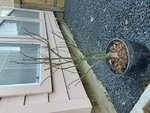canoeanu
Seedling
Hello all. I'm a huge plant nut. My husband got me a tree to "begin" my bonsai journey. I realize every tree is a very unique journey. I struggle with it because the type A part of me wants a clear order of operations (you'll notice...). I know the general path people take for a deciduous bonsai tree, but my husband gifted me a unique tree that he picked out from a nursery with some unusual features that make this complicated for me.
Its a shishigashira and it looks to be around 3-4 years old.
There is probably 6 inches on the original trunk before it was cut back hard and a branch took over the trunk. From that cut back, there are a lot of new branches, which is great for now. Eventually I'll have to make some decisions about these branches, but I'd like to put that off for as long as possible. My immediate goal is to thicken the trunk, especially the lower part, to prevent an inverse taper and to create a more dramatic trunk base. I worry if this section of the trunk isn't thickened, its very likely to go inverse further up on the trunk. However, there isn't a single branch in that lower part of the trunk to use as a sacrificial branch. I need to figure out how to encourage that to bud.
Bury it or pot it?
I'm having difficulty deciding which one is best. If I bury it, it will be in the only spot I have available. probably imperfect but alright lighting. I know it will stay moist longer. I know it will thicken faster. But you run the risk that you have to do drastic root pruning to get rid of the feeder roots and make that nice radial structure. If I pot it (I was thinking large basin style pot with the right organic soil mixture for Japanese maples, so plenty of room to grow), I can clean up the roots before potting it. I can move it to the perfect lighting. but this method is slower than in ground, which isn't too big of a deal. Main con: I don't know if this method will be enough to encourage a new shoot at the base of the trunk to be a sacrificial branch.
Cut back branches/foliage?
What do I need to cut back in order to encourage branches to develop on the lower trunk? Is it bad to consider pruning (with cutpaste) if I know I have to clean up the roots and pot it?
In general:
I can't seem to figure out how to encourage a brand new branch to grow on the lower part of my tree.
Its a shishigashira and it looks to be around 3-4 years old.
There is probably 6 inches on the original trunk before it was cut back hard and a branch took over the trunk. From that cut back, there are a lot of new branches, which is great for now. Eventually I'll have to make some decisions about these branches, but I'd like to put that off for as long as possible. My immediate goal is to thicken the trunk, especially the lower part, to prevent an inverse taper and to create a more dramatic trunk base. I worry if this section of the trunk isn't thickened, its very likely to go inverse further up on the trunk. However, there isn't a single branch in that lower part of the trunk to use as a sacrificial branch. I need to figure out how to encourage that to bud.
Bury it or pot it?
I'm having difficulty deciding which one is best. If I bury it, it will be in the only spot I have available. probably imperfect but alright lighting. I know it will stay moist longer. I know it will thicken faster. But you run the risk that you have to do drastic root pruning to get rid of the feeder roots and make that nice radial structure. If I pot it (I was thinking large basin style pot with the right organic soil mixture for Japanese maples, so plenty of room to grow), I can clean up the roots before potting it. I can move it to the perfect lighting. but this method is slower than in ground, which isn't too big of a deal. Main con: I don't know if this method will be enough to encourage a new shoot at the base of the trunk to be a sacrificial branch.
Cut back branches/foliage?
What do I need to cut back in order to encourage branches to develop on the lower trunk? Is it bad to consider pruning (with cutpaste) if I know I have to clean up the roots and pot it?
In general:
I can't seem to figure out how to encourage a brand new branch to grow on the lower part of my tree.








